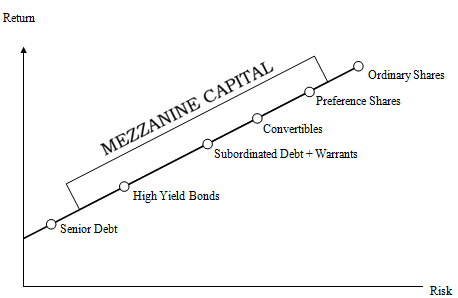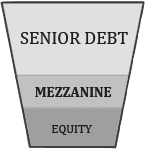Financing solutions
Mezzanine finance
Essentia is one of the few companies in the Baltics offering advisory services for finding mezzanine capital throughout the Central and Eastern Europe.
MEZZANINE: ESSENCE AND USAGE
Mezzanine means literally in the middle, thus mezzanine financing refers to a hybrid capital ayer on the company's balance sheet in between debt and equity.
Mezzanine capital is ranked behind senior debt in terms of security and cash payments, both interest and principal. In return, it will demand a higher return than senior debt. But as a quasi-equity instrument it usually ranks above the shareholders. As an instrument, mezzanine can be regarded as debt or equity therefore mezzanine can be also considered rather as cheap equty rahter than an expensive loan.

The drawing above states that no matter how the instrument is technically structured it can be still regarded as a mezzanine if it corresponds to certain characteristics. The latter means that the loan must be typically structured to offer the mezzanine lender some form of equity upside, providing the chance to share in any uplift in the company’s equity value through warrants or options.
For defining the usage of mezzanine it is crucial to stress that it is typically not used for covering day-to-day operations (working capital) because it should be rather used during transitional periods in the life of a company when extra financing is required. Also, mezzanine is a product not meant for start-ups or early stage companies.
Where is mezzanine used then?
To achieve a clear picture we have pointed out the most typical list of financing needs that can be addressed by offering mezzanine:
- acquisitions and management buyouts,
- business expansion,
- recapitalizations,
- new product launches and diversification,
- long-term working capital to support growth,
- equipment and owner-occupied real estate purchases, dividends.
Mezzanine investors look for companies with the following characteristics:
- Proven and predictable cash-flow
- Well-established operations
- Clear competitive advantage(s)
- Reasonable and sustainable market position
- Strong and focused management team
- Predictable exit route
- Alignment of interest
- Prudent and transparent accounting and budgeting
MEZZANINE RATIONALE
Mezzanine fills the gap between debt and equity in many transactions such as buyouts. However it has also proven to be effective in financing other activities such as refinancing and expansion.
Using mezzanine for recapitalisation and ownership restructuring deals enables companies to streamline their existing debt structure thus reducing the proportion of short-term amortising debt. Mezzanine can also be used to buy-out minority shareholders or in some cases it may be even used by existing shareholders to achieve liquidity without ceding control. While equity investment may be attractive to some businesses because it does not require interest payments or principal amortization it may also involve higher long-term costs, the inability to exit, and management control issues. Therefore, mezzanine financing may offer the advantages of a lower cost, no management control, and a predefined exit arrangement
It is obvious that mezzanine providers are not competitors to banks or equity sponsors but rather co-operate and support them in expansion, restructuring, recapitalisation and buy-out deals.
Mezzaninine

Mezzanine is a hybrid financing instrument that shares the characteristics of both debt and equity.